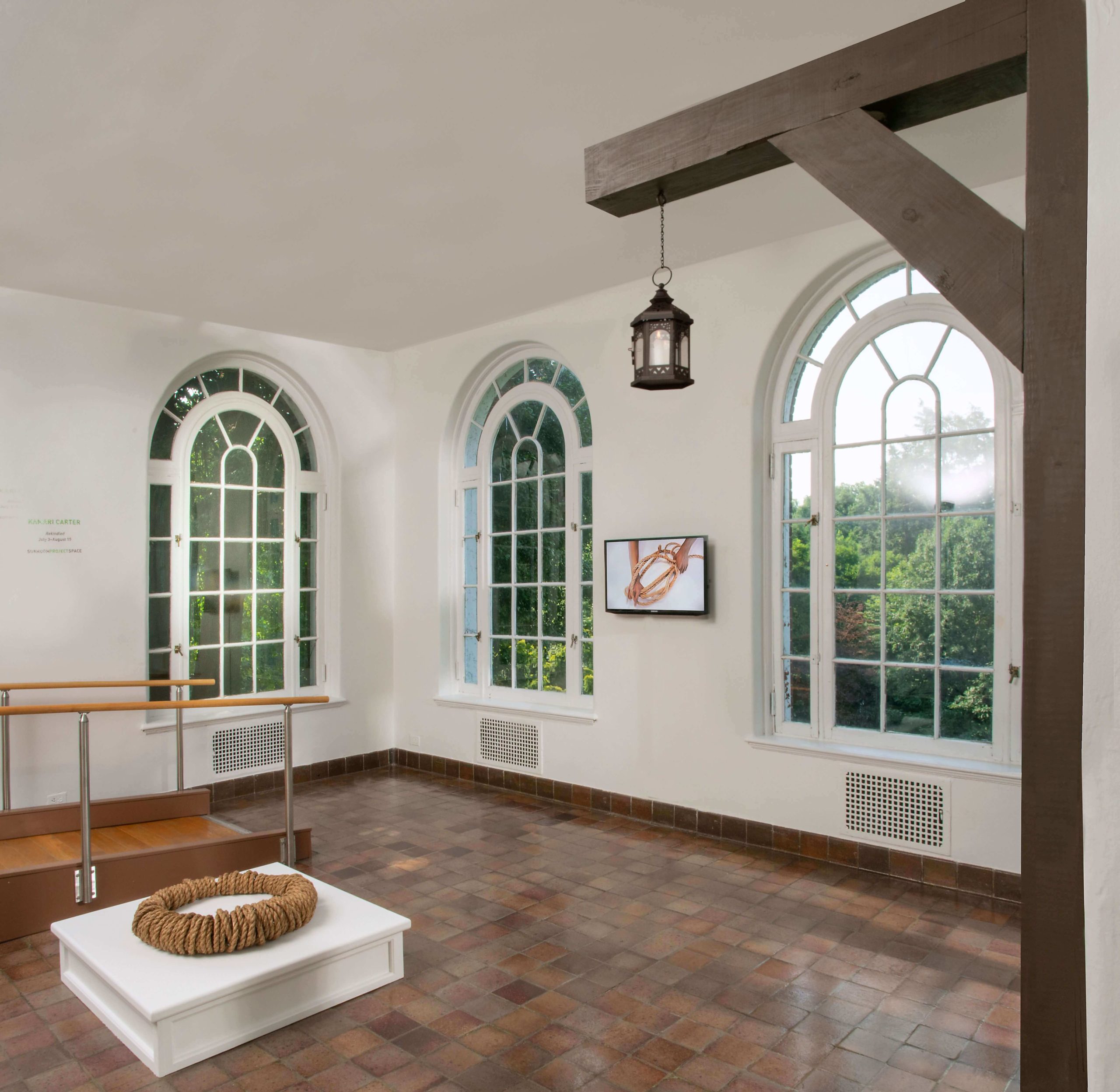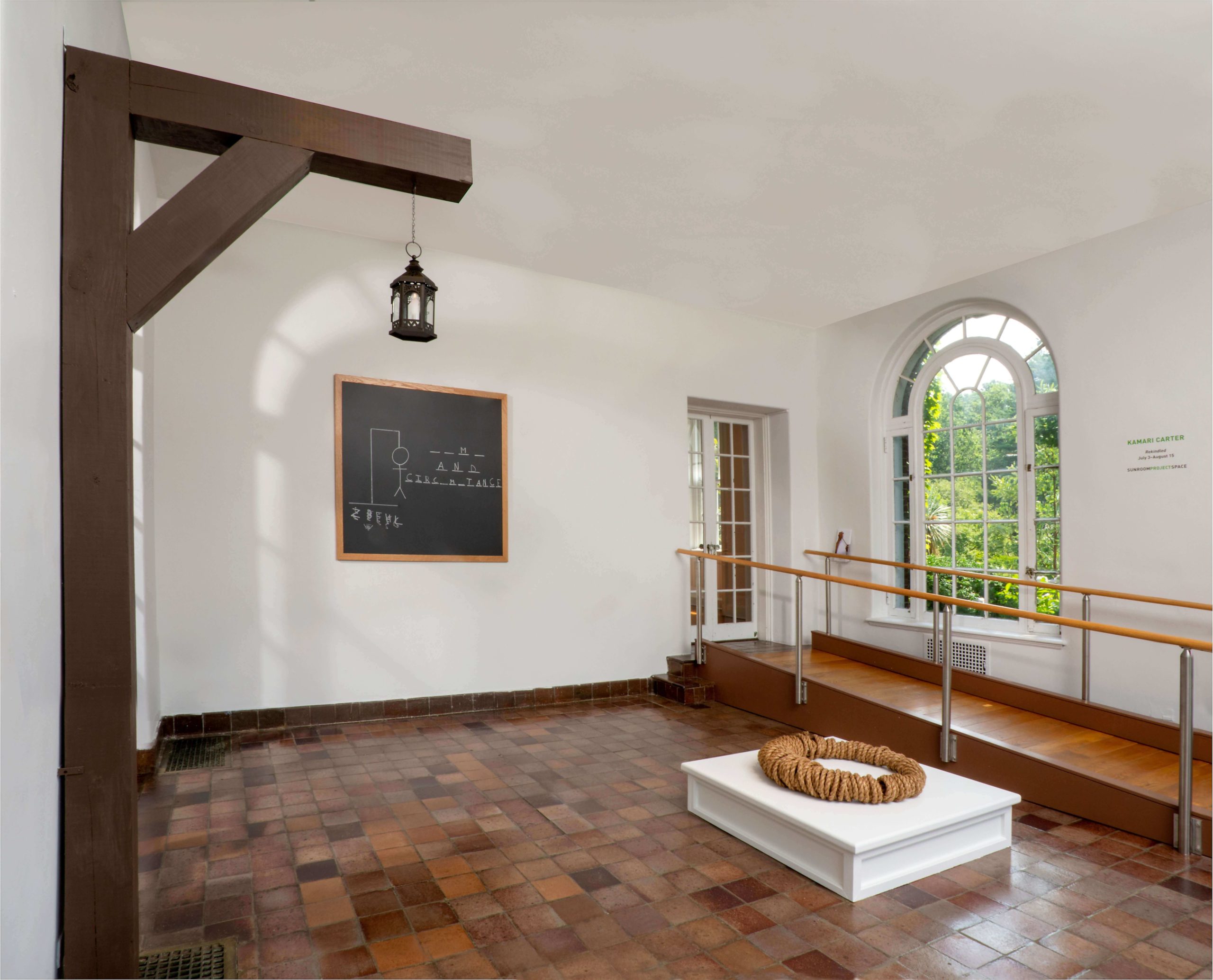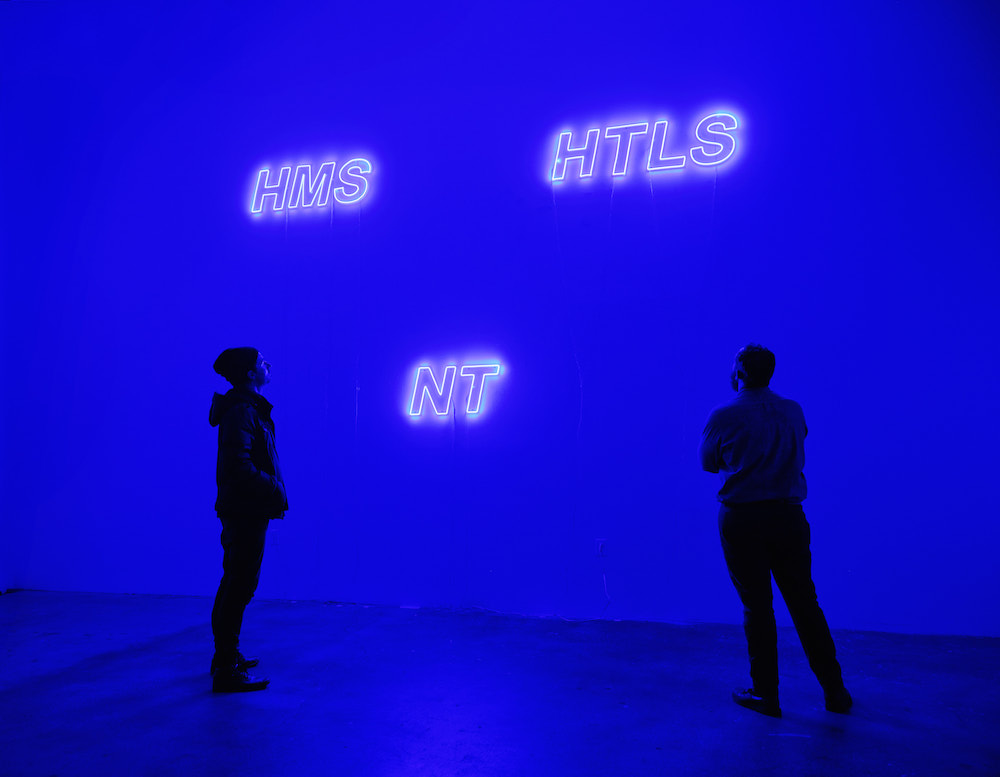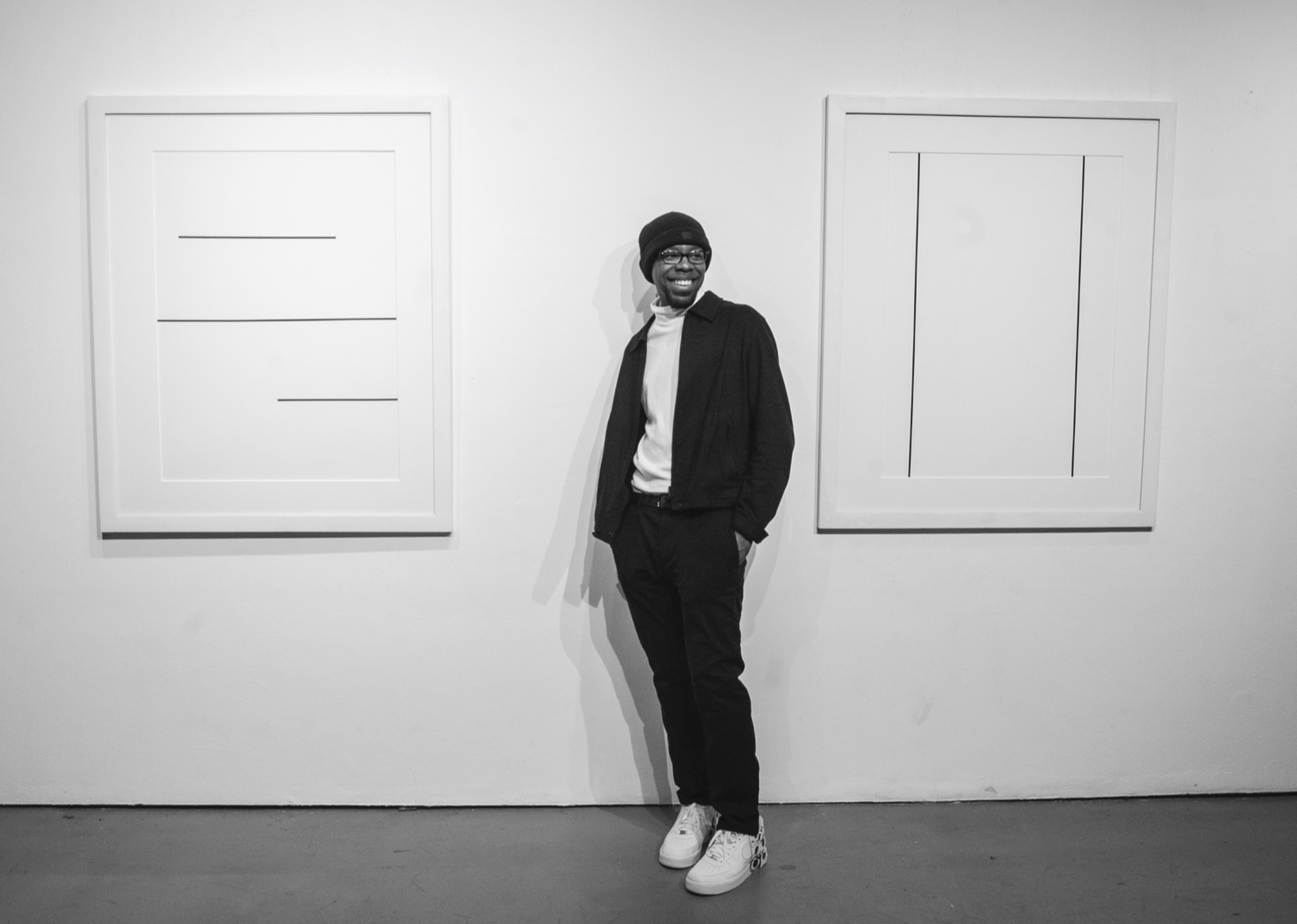November 17, 1793, was a Sunday. In Albany, NY most church-going people had settled in for the evening and were dozing off, when, as historian Joel Munsell later wrote, they were roused by the “alarming cry of fire.” The flames spread quickly, destroying more than two-dozen homes, and marking the first major fire in the city’s history. But the fire is disturbing and noteworthy for another reason—in trying to determine its origins, city leaders convicted and executed three enslaved children, Pompey, Dinah, and Bett, who were aged 16, 14, and 12, respectively.
Their story became the foundation for Rekindled, a multimedia installation on view at Wave Hill this past summer by artist, musician, and sound designer Kamari Carter. Right before the 2020 presidential election, Carter was driving up from New York City to the Catskills, where he was starting a residency. “I noticed that everything gets more conservative, and it didn’t seem to match the energy that I have known New York City to have,” he told us over Zoom. He remembered thinking, “There must be something here, and there must be something about the history of New York State that I’m simply unaware of.”
Carter began researching the history of New York State, digging into a tumultuous past. “That’s when I stumbled upon this story,” he said. “About 60 percent of the downtown section of Albany had burned down, and it involved these two young girls, but there’s very little known about the people who committed the arson, or supposed arson.”
Carter referred to the fact that, although Dinah and Bett confessed to starting the fire, their testimonies must be treated with skepticism. The girls would have been under threat, promised freedom, and, in all likelihood, terrified from being jailed and tried. And we cannot neglect how young they were. Pompey’s version of the story also changed throughout the process—he later professed the girls’s innocence. Their conviction would have been convenient for leaders who both wanted to locate blame and make an example of what happened to rebellious enslaved people during the so-called “Age of Revolutions.”
At Wave Hill, Carter staged a quiet, deliberate installation that offered the space to reconsider this forgotten and misunderstood history. The gallery was full of natural light; large, arched windows sent curved sunbeams around the artworks.

Installation view of Kamari Carter at Wave Hill, courtesy of the artist and Wave Hill.
Greeting you from the entry ramp was Ligature/Signature, a video installation featuring two hands struggling with a piece of rope. Off-screen, someone throws more rope at the two unidentified hands, increasing the level of struggle. The visual was accompanied by a mildly unsettling soundscape: hard rope landing on a table, skin rubbing against twine.
“I really wanted the feeling of pulling and tugging and anguish to be felt through the moving image, but I didn’t want it to be forced,” Carter explained. “So that’s how I arrived at this somewhat performative, slightly anxiety-inducing moving image that’s no longer than like two minutes and 30 seconds.” The other aspect of this slightly anxiety-inducing image was that the sound could be heard throughout the space. As you turned your back to the video, to face the three other works, Ligature/Signature created a kind of hushed, rhythmic discomfort that heightened your awareness to the rest of the installation. Every object seemed to have a dual purpose, engaging all senses as you prickled with discomfort.
It was Carter’s hands that you saw in the video, a planned move on his part. “While I am pulling and tugging and finding the yield point and putting this rope under duress, I’m also making an attempt to use the different angles of the rope to spell my own name,” he said. The choice goes back to what the work was supposed to do—offer room to self reflect. More than that, Carter emphasized that “it was really important for me to do what I could to put myself in some of the work because as a Black body, it is an important issue, not just in general, but very specifically to me.”
The three other works were spaced out in a triangle, in what came to feel like an early American classroom. On the far wall, Carter installed a backboard with an unfinished game of hangman. The viewer filled in the blanks—our mind went to “time and circumstance,” but the intention was “pomp and circumstance,” a nod to Pompey. As Carter noted, it also alluded to the march used at high school graduation ceremonies, speaking to youth and preparation for the future.
The blackboard was a kind of apex, pulling together the remaining works: one, a delicate lantern hanging from a gallows-like sculpture, and the other, a heavily coiled rope. The lamp eerily alluded to the object that initially set the fire—hot coals in a lantern, set on a stack of hay—as well as the three executions by lynching. Carter explained that the coiled rope was based on an old urban legend he found—that there was a time when people would coil the neck of a noose 13 times. And so, he asked, “What would happen if the coiling was indefinite?”

Installation view of Kamari Carter at Wave Hill, courtesy of the artist and Wave Hill.
The coiled rope formed a loop. When Carter was making it, he noted, “It’s a very strange thing to make a noose because you can kind of feel the history. In the process of doing it, I could immediately understand, yeah, this is the sole reason that something like this would be used.” The infinite loop was made from 120 feet of rope, a reference to the Emmett Till Anti-Lynching Act, first brought to the Senate in 1900 but not passed until 2020. As Carter put it, “I equated 120 years of inaction to 120 feet of rope.”
Rekindled is marked by a subtle Socratic method, probing a dialogue between viewer, artist, and artwork. Carter’s approach is minimalist, clearing away the clutter so you can interrogate yourself, your space, and commune with the artwork. Unlike some of his earlier works, like Blissville (2020), which was more about contrarianism, Carter told us that Rekindled is “much more about taking a series of unfortunate events about the pawns in this grand scheme of systemic racism and trying to uplift the girls’ narrative more than the narrative that is told about them by others.”
Wave Hill is in Riverdale, a short train ride from Manhattan; it’s a peaceful enclave with expansive views of the Hudson. In its first life, Wave Hill was a mansion owned by a prominent publisher and leased by figures like Theodore Roosevelt and Mark Twain. Today, it is a sloping park and well-loved art institution. Walking around the grounds, from the fieldstone mansion to the shallow pool, you catch different floral and herbal scents in the breeze.
In the context of Rekindled, the site feels different, reminding you that the histories you know focus on the Roosevelts and Twains, who inhabited structures built by enslaved and oppressed people. As Dr. A.J. Williams-Meyers told Hudson Valley, “New York was not a society with slaves, it was a slave society, dependent on enslaved Africans.” Carter points to this history, enabled by the Hudson River, as well as “the question of nomenclature, having monuments, and in a certain sense, trees, because of the Hangman’s Elm.”
On our visit to the space, as we clocked the clientele and breezy veranda, the site seemed reminiscent of a country club. For Carter, the clientele increased the momentum of the exhibition. “I think that this kind of exhibition should happen at a place like Wave Hill,” he offered. “The clientele at Wave Hill are probably not going to be exposed to that on the day-to-day. So, it was important to make this work for this space, not because of the space itself, but because of who would see it.”
Rekindled defines a “teachable moment.” Carter presented a history in such a way that, without demurring from its intensity, the viewer could take time to pause, study, and consider their own experience. “I didn’t want anyone to come in and leave thinking the exact same way as myself, I still wanted their own anecdotal context to be brought to all the works,” he added. “Take what you will, but please take something.”

Kamari Carter’s “Blissville,” 2020, photo by Julian Day, courtesy of the artist.










